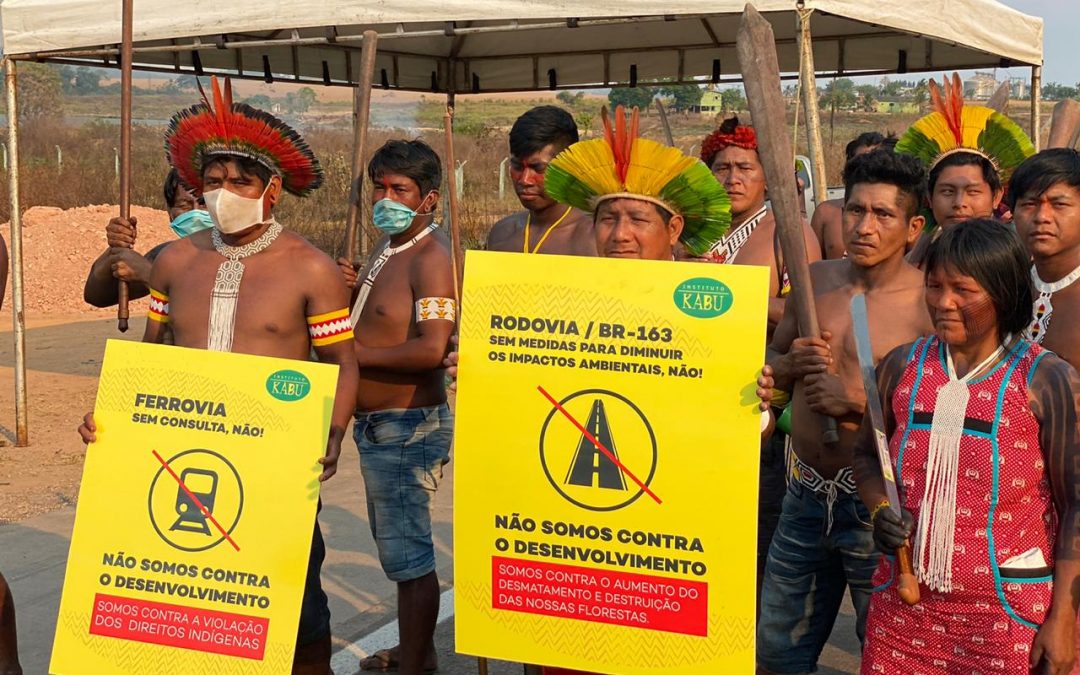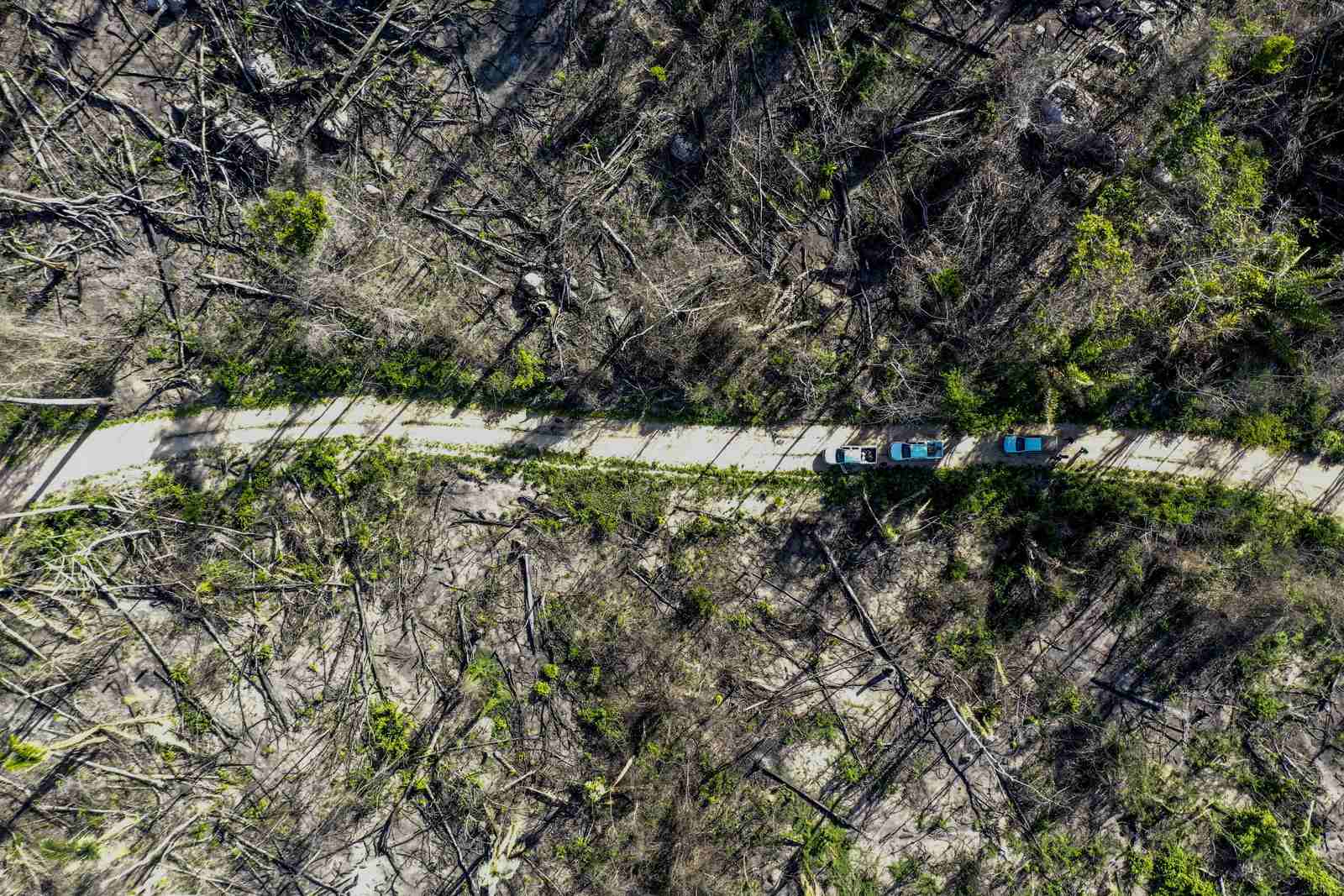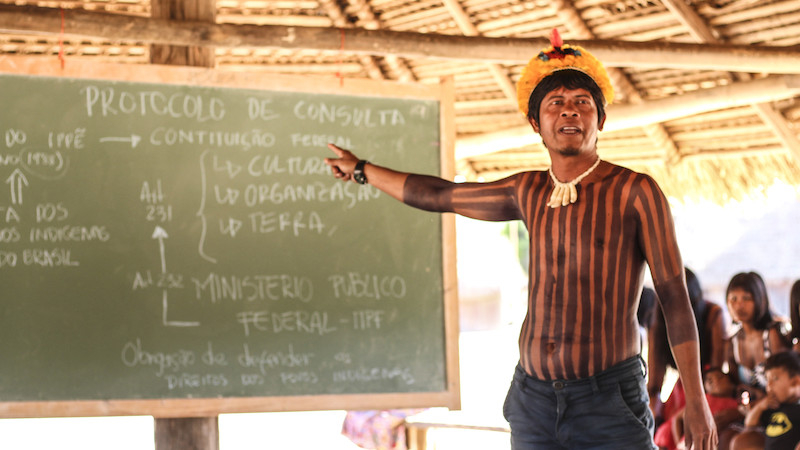In mid-August, Kayapó indigenous people took yellow posters not only to the middle of the federal road known as BR-163 but also to the world’s headlines. Taking extra risks because of Covid-19, they left their villages and occupied the road that connects Cuiabá, in Mato Grosso, to Santarém, in Pará, in the middle of the Amazon. They were there to claim the renewal of the Basic Environmental Plan – Indigenous Component (PBA-CI), which is part of the road’s licensing.
The demonstration took place in the town of Novo Progresso, state of Pará – the epicenter of the August 2019 “Fire Day.” And it has borne fruit: this month, a court ordered the Federal Government to renew the plan, which helps minimize the impacts of the road’s construction works. The plan is a set of actions ranging from protection and monitoring of the Indigenous Lands Menkragnoti, Baú and Panará by the communities themselves to implementing sustainable economic alternatives. It became effective in 2008 as a condition for granting the environmental license to resume paving works on BR-163 in the same year.
The Plan sets the Executive’s commitments to safeguarding basic rights for Indigenous Peoples: from funds to maintain programs enabling surveillance of the territory against encroachers that deforest and burn to the operation of the Kabu Institute, which enables service management – including health care, in the middle of the new coronavirus pandemic.

Throughout the debates about renewing the program, Brazil’s indigenous affairs agency Funai (the National Indigenous Foundation) argued that ‘caution’ was needed in dealing with the issue – a stance similar to that adopted by the National Department of Transport Infrastructure (DNIT) since December last year , when the 4th addendum to the Plan expired.
However, on September 1, a federal court granted an injunction reaffirming the need to keep the Plan, following a public civil lawsuit filed by the Federal Prosecution Service (MPF). It ordered DNIT to send work plans for the renewal of the Plan to Funai by September 29.
In her decision, Judge Maria Carolina Valente do Carmo of the Federal Court of Altamira emphasized what had been established by the plan itself regarding its “permanent character, since the impacts resulting from the project tend to increase over the years.” She also ordered DNIT and Funai to present proof of the renewal of the Indigenous Component of the Plan regarding the Menkragnoti, Baú and Panará Indigenous Lands by mid-October.
DNIT asked the court for an extension of the deadline and the Federal Government argued that, since it intends to grant the concession of the road to the private sector (it was sent to the Federal Court of Accounts in May), it would no longer be responsible for its socio-environmental impacts, in addition to questioning the urgency of meeting indigenous peoples’ demands.
Judge Do Carmo, however, did not grant these requests and reinforced that “there is higher risk of irreversibility of indigenous people’s losses if renewal of the Plan is postponed indefinitely.” In a complementary decision, she set a 5,000-real fine for each day of non-compliance with the full decision.
“Actions essential to physical and cultural reproduction”
“They always say that it is under analysis, that they are looking into it, that they are already solving it. Then they set a date. But that’s crap! Nothing gets solved. Everyone knows that Funai should be there to accommodate our demands, but they don’t care about indigenous people anymore,” says Mydjere Kayapó, vice president of the Kabu Institute. The indigenous organization gathers villages from the Menkragnoti and Baú Indigenous Lands and has managed resources transferred by the federal government under the Plan since 2010. According to Funai, the transfers, which also include funds directed to the Panará association, amounted to R$ 39 million since the program began in 2008.
In the public civil lawsuit that resulted in the injunction to renew the plan, prosecutors argued that mitigation actions are “essential to the physical and cultural reproduction of the Kayapó Mekrãgnoti and Panará peoples, and that they must persist as long as the growing impacts of the road on their territories persist.”
The same Court decision also prohibited the Brazilian Institute of the Environment and Renewable Natural Resources (Ibama) from granting a definitive operating license for paving the BR-163 road until proof of renewal is produced.

“When we had the Plan, we did our monitoring, our own surveillance. That’s why the federal government may not want to renew the Plan, so we can’t monitor it,” adds Mydjere. “Miners and loggers are entering indigenous lands with full strength. There are even some indigenous people who favor this, who are involved, [who are] deceived by the miners and the loggers. They like to call the indigenous people to protect themselves, saying that the timber belongs to the indigenous people. They always use that.”
Asked by Repórter Brasil about the irregular condition of the BR-163 construction project regarding environmental licensing, Funai did not comment. The Ministry of Infrastructure, in turn, vaguely informed that the “government has maintained constant dialogue about the topic with the communities” and that “DNIT and Funai are negotiating, with the assistance of the Ministry of Infrastructure and the Investment Partnership Program (PPI), to renew the Basic Environmental Plan – Indigenous Component.”
In mid-August, on the eve of the announced indigenous road blockade, an emergency transfer of R$ 2.3 million was made under an addendum referring to the first half of 2020, but the proposal to renew the Plan for 2020-2024 still lacks any official answer – now required by the Courts.
Proper health care in communities is also part of the demands of indigenous people, who also released an open letter and a statement addressed to Funai. “Then Covid-19 arrived as an invisible enemy of indigenous people. It has already killed four of our elders on our land,” reports the vice president of Kabu. “And fires are major around here. If you come, you’ll see that everything is huge here.”
A new chapter: Ferrogrão
Mydjere Kayapó describes what the records of the National Institute for Space Research (Inpe) have also been pointing out. The outbreaks detected in these territories on August 1-15 have largely surpassed the average of the last decade. According to a survey based on data obtained using the Aqua satellite and taking into account the 100 km of the boundaries of the Baú and Menkragnoti Indigenous Lands, there were 3,079 fire outbreaks – 90.7 percent of the average of the last ten years (3,389) for the whole of August (see heatmap below). A large part of those fires occurred right by the BR-163 road.
The relationship between safeguarding rights and deforestation is the focus of a study recently published in the United States and conducted by the University of California at San Diego and the University of Columbia. The investigation pointed out that safeguarding indigenous territorial rights could have reduced deforestation by 1.5 million hectares in the Brazilian Amazon.
According to political scientists and authors Kathryn Baragwanath and Ella Bayi, the standstill in homologation of indigenous lands, together with the increase in violence toward indigenous peoples and Bolsonaro’s claims that he will “open” these lands to mining and agricultural interests highlight “the importance of an institutional system which will recognize these property rights”, which had calculated effects of reducing deforestation by up to 66%. In addition to the demarcations, the work published by the National Academy of Sciences also highlights the necessary “strengthening [of] existing mechanisms that protect indigenous territories from extractive activities.”
Along this line, Mydjere Kayapó stressed that another important point in the indigenous peoples’ demands is the consultation regarding the construction of Ferrogrão, supposed to be the most important grain transportation railroad – parallel to the BR-163. “When the analysis takes place, or a hearing on Ferrogrão, then federal and the state governments and those who want to do it should call us, the Indigenous Peoples, to listen to us too,” he stresses.
Part of the Federal Government’s Investment Partnerships Program (PPI), the 1,000-kilometer-plus Ferrogrão project is the result of a proposal supported by the Pirarara consortium. The group includes trading companies that control the soy market – ADM, Amaggi , Bunge, Cargill and Louis Dreyfus – and put together by Estação da Luz Participações (EDLP), a company specializing in logistics projects. In a round of meetings with potential operators, funders and investors of the construction – whose cost for a 69-year concession is estimated at R$ 8.4 billion for implementation only – government officials reported that socio-environmental issues were among the most often cited concerns.
A survey by the Climate Policy Initiative – a center for evaluation of climate policies affiliated with the Pontifical Catholic University of Rio de Janeiro (PUC-RJ) – estimated that, if no mitigation measures are taken, the project may increase the demand for land and induce deforestation of 2,043 km² of native vegetation in Mato Grosso.
The Ministry of Infrastructure’s press office informed that licensing for the construction work is still in its early stages, but the lands of the Kayapó People are located beyond the limits established as areas of influence of the projected railway. The Xingu+ Network, which includes indigenous peoples’ organizations, traditional communities’ associations and civil society institutions operating in the Xingu River basin, disputes the ministry’s view and continues to demand free, prior and informed consultation with the indigenous peoples regarding the construction work.
The Panará People: “Our situation is very complicated”
The Panará indigenous people – arguably the most historically affected by the paving of the Cuiabá-Santarém Road, since their population was reduced by more than 80 percent – were also benefited by the decision of the Federal Court of Altamira to renew the Plan under the Prosecution Service’s action.
“We won. Yes, it has to continue. Because it’s our right. These funds [of the PBA-CI of BR-163] have to be kept so we can do our inspection work and protect our area, the forest can remain standing, the river can remain clean, we can be fed,” says Kunity Panará from the Iakiô Association, mentioned in the decision as the recipient of funds related to the mitigation of the road’s impacts. The Panará people, he continues, “suffer the impacts of the asphalt” to this day.

“Big farmers are deforesting near our area. Deforestation for cattle, soy, logging, burnings is already very close,” says Kunity. “When the government started opening BR-163, the Cuiabá-Santarém road, it passed over our villages, our cemetery. Because of that, we lost many of our relatives, our family, in the hands of the government. The road ‘cleaned up’ our villages, our cemetery,” he said with sadness. When the most recent stage of the works started, “they were”, according to him, “deceiving a lot,” “making many promises,” without fulfilling “what’s written.”
One of the promises most often remembered by the indigenous peoples is a road branch to facilitate access to their villages, also included in the decision of the Altamira judge “We are losing some of our relatives, who were taken to doctor appointments or treatment. We have lost relatives in the middle of the road because there is a lot of mud, fallen trees, bridges collapsing because of the rain,” he says, describing deaths resulting from lack of structure and neglect in community health care.
“This year we are suffering even more. Our situation is very complicated. We are here in the village and the whole of Brazil is at war with Covid-19, we have no support, no resources to help our communities.” There are six Panará villages with about 600 people.” We need the Plan’s resources to continue because the road will never end.”


